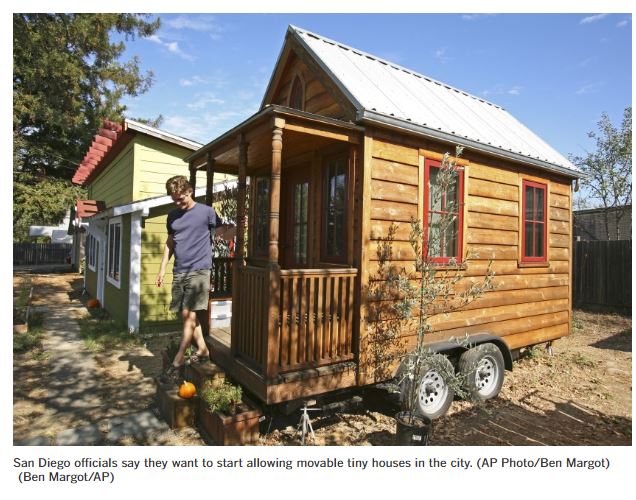Here’s how we can get the cost of ADUs down (hopefully):
San Diego officials say they plan to begin allowing movable “tiny houses” in backyards across the city, to help address the local homelessness and affordable housing crises.
The tiny houses, which are similar to granny flats but smaller, can be built more quickly and cheaply than granny flats and will create a new source of low-cost housing — without any government subsidies, city officials said this week.
“I think this is a good, common-sense solution that provides some possibilities for non-subsidized, market-rate type housing,” Councilman Scott Sherman said Wednesday during a meeting of the council’s Land Use and Housing committee. “It’s one small step in dealing with our housing crisis.”
The committee voted unanimously to direct City Attorney Mara Elliott to draft an amendment to San Diego’s municipal code that would allow movable tiny houses as long as property owners adhere to a long list of restrictions and requirements.
Under San Diego’s proposed regulations, movable tiny houses would range in size from 150 to 430 square feet. They would have fire-resistant roofs and would need to be connected to sewer, water and electricity.
While movable tiny houses have wheels, city officials said, they aren’t like a conventional trailer or recreational vehicle. Instead, they are built like a traditional home, with interior space geared for daily living.
They could not be rented out for fewer than 30 days at a time, so they can’t be used as short-term vacation rentals.
Property owners would not be required to provide an on-site parking spot for the tiny house.
They would have to be registered with the Department of Motor Vehicles, but they couldn’t move under their own power. And the wheels couldn’t be removed because they’re needed to support the structure.
Despite the tiny houses being potential competition, the local development community supports the effort.
“Everyone pretty much agrees that the old ways of doing things are not going to get us out of this crisis,” said Matt Adams, vice president of the local chapter of the Building Industry Association. “It’s creative, it’s innovative and you have other jurisdictions around the nation exploring it.”
A property owner can have a movable tiny house installed on their property within 30 to 45 days, much less time than the six to 18 months it typically takes to add a granny flat, said Barrett Tetlow, Councilman Sherman’s chief of staff.
The process takes less time because the movable tiny houses are pre-fabricated and then shipped to property owners, while granny flats are typically constructed on-site and require a lengthier approval process.
Tetlow said a tiny house will typically cost about $85,000 total, compared to somewhere between $100,000 and $150,000 for a granny flat, which is usually between 500 and 1,000 square feet in size.
With tiny houses renting for an estimated $900 per month, Tetlow said, a property owner would recover their initial investment in about eight years. After that, the rent from the tiny house could help cover their mortgage payment or other expenses.
The tiny houses would become a new rung on the housing ladder, above homelessness and potentially above subsidized low-income housing, Tetlow said.
Link to UT article




Despite the tiny houses being potential competition, the local development community supports the effort.